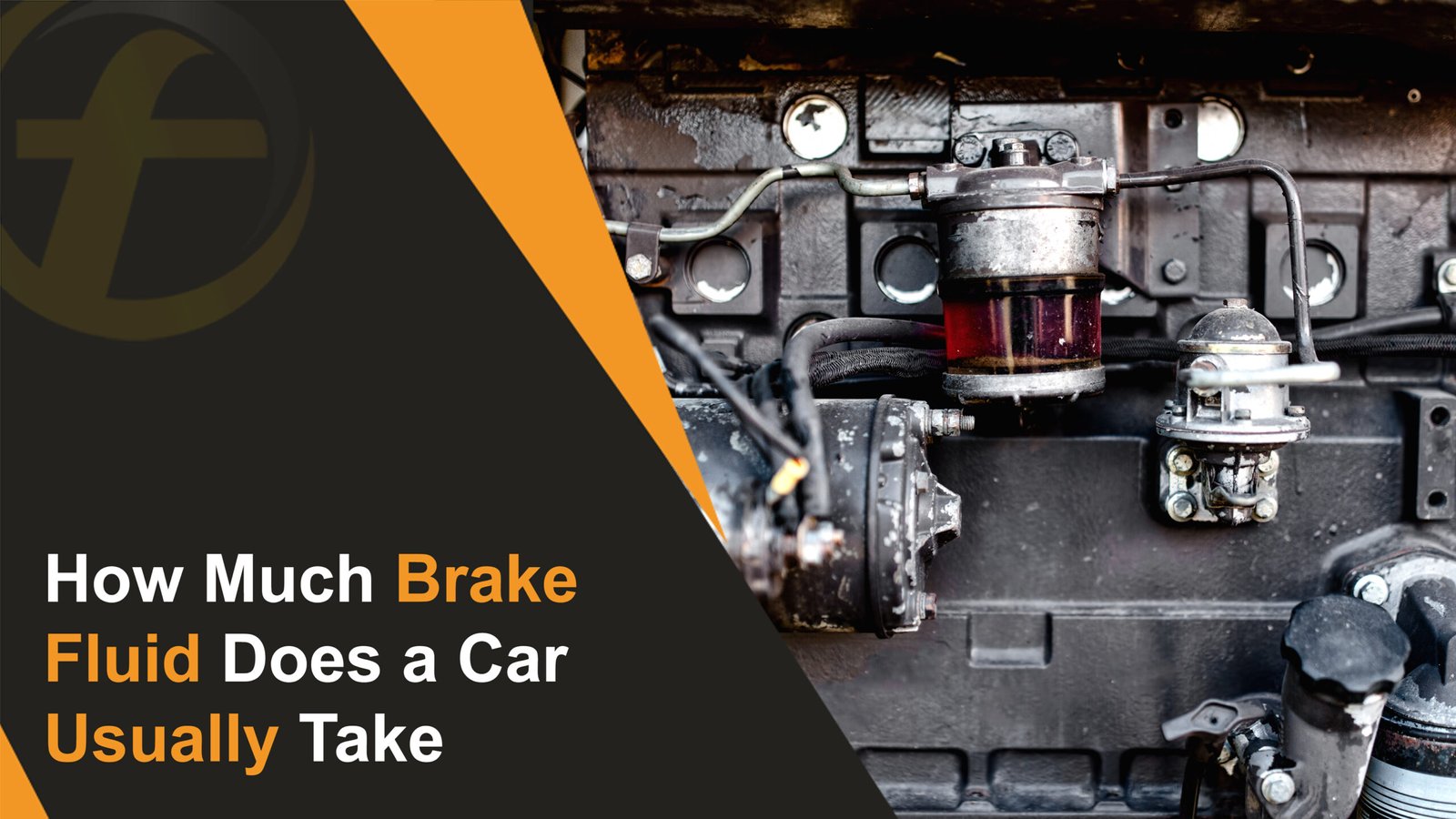
Brake fluid is one of the most essential liquids in your car, but it’s often forgotten during maintenance. It helps your brakes work smoothly every time you press the pedal. Without enough brake fluid, your car might take longer to stop or even fail to stop safely.
At Fubex Lubricants, we offer high-quality brake fluid for all types of engines. Enjoy fast shipping, a price match guarantee, and no-questions-asked returns. Need help choosing the right oil? Call us at +971 50 544 9614 — our friendly team is ready to assist!
Most cars need about 1 liter of brake fluid, but the exact amount depends on your vehicle’s make and model. In this guide, we’ll explain how much brake fluid your car needs, which type to use, how often to change it, and simple steps to keep your braking system safe and strong.
What is Brake Fluid and Why is it Important?
Brake fluid is a special liquid that helps your car stop when you press the brake pedal. It moves through small tubes called brake lines, pushing the brake pads against the rotors or drums to slow down your car.
When performing brake maintenance, you need to bleed the brakes — this involves removing old fluid and air bubbles to ensure the system operates smoothly.
Brake fluid should not be squishy or soft. If it feels that way, it might have air bubbles or overheating problems. Most modern cars use hydraulic brakes, which utilize brake fluid to amplify the pressure from your foot.
Having the right type and amount of brake fluid is very important for safety. If your car doesn’t have enough, your brakes won’t work correctly, and that can be dangerous. Always keep your brake fluid clean, complete, and fresh for optimal braking performance.
How Much Brake Fluid Does My Car Need?
To know how much brake fluid your car needs, check your car’s owner’s manual. It will provide the correct amount for your car’s make and model. Most cars typically require approximately 1 liter of DOT 4 brake fluid.
Which Brake Fluid Should I Use For My Car?
There are two main types of brake fluids: glycol-based and silicone-based.
The “DOT” number shows how high the brake fluid’s boiling point is. A higher DOT number indicates that the fluid can withstand higher temperatures.
For example, if you have a sports or racing car, you’ll need brake fluid with a higher DOT rating, because it can handle higher temperatures. For regular vehicles, DOT 3 or DOT 4 is usually recommended.
How Often Should I Change My Brake Fluid?
Most car manufacturers recommend changing your brake fluid every 2 years, regardless of your driving habits. Even if it looks clean, it can still lose its strength over time. The best way to confirm is to check your car’s manual.
It’s also a good idea to check your brake fluid every few weeks to ensure everything is in order. Never mix different types of brake fluid, because they can react badly and damage your brake system. Be careful with DOT 3 and DOT 4 fluids, as they can damage your car’s paint if spilled.
To keep your brakes working safely, it’s recommended to always use fresh brake fluid when changing or topping up.
How To Change Your Brake Fluid
Changing your brake fluid isn’t too hard, but it’s best to ask a friend to help. You can use a “one-man” bleed kit, but having someone press the brake pedal for you makes it easier.
Drain The Old Brake Fluid
Remove the cap from the brake master cylinder (located under the hood, near the small tank). Use a syringe or similar tool to remove as much old brake fluid as possible and place it in a container. Then, lift your car safely on stands and remove all four wheels.
Add New Brake Fluid
Wipe the master cylinder clean with a lint-free cloth to remove dirt. Then, fill it up to the MAX line with new brake fluid from a sealed container (old or opened bottles can collect moisture). Check your car’s manual to ensure you’re using the correct type, such as DOT 3, DOT 4, or DOT 5.
Flush The Brakes
Each brake has a small bleed valve (also called a nipple). Spray it with brake cleaner to remove dirt. Attach a rubber tube to the valve and insert the other end into the container containing old brake fluid.
Get Your Helper Ready
Ask your helper to sit in the driver’s seat. Place a small block under the brake pedal so it doesn’t go all the way down.
Now open the bleed valve and tell your helper to press the pedal down when you say “DOWN,” and release it when you say “UP.”
You’ll see old fluid and air bubbles come out. Continue this process until clear, new fluid comes through with no bubbles.
Keep Topping Up
Watch the master cylinder — don’t let it get too low! Add more new brake fluid as you go, so no air gets into the system.
6) Repeat And Finish
Do the same steps for each brake, moving from the farthest wheel to the nearest. When done, your brake pedal should feel firm — that means you’ve done it right!
Check the fluid one last time, top it up if necessary, close everything, and reinstall your wheels. Finally, dispose of the old brake fluid properly — don’t pour it down the drain. Please take it to your local recycling center instead.
How to Add Brake Fluid
Changing or adding brake fluid can be tricky, so it’s best done by two people or a professional mechanic. One person presses the brake pedal, and the other handles the old fluid to make sure no air gets into the system.
Step 1: Remove The Old Fluid
Open the master cylinder (you’ll find it under the hood). Use a syringe or similar tool to take out the old fluid and pour it into a safe container. Never throw it in the trash or down the drain, because it’s harmful to the environment.
Step 2: Get to the Brakes
You’ll need to lift the car and remove all the wheels to reach the brakes. Most people don’t have this equipment at home, so it might be easier and safer to visit a professional garage.
Once you have access, fill the master cylinder with fresh brake fluid. This new fluid will push the old one out as you flush the system.
Step 3: Know How Much Fluid You Need
Check your car’s manual to determine the exact amount your vehicle requires. Most cars use about 500 ml for a regular flush, but if your old fluid is dark or burned, you may need around 1 liter to replace it entirely.
Step 4: Flush the brakes
Ask your helper to sit in the driver’s seat. Locate the bleed valve (also known as a nipple) on the brake caliper and connect a small hose to it. The other end of the hose should go into your container for the old fluid.
When your helper presses the brake pedal down, open the valve to allow the old fluid to drain out. Then, close the valve before they lift their foot. This keeps air from entering the system.
Repeat this process until clear, new fluid comes out with no bubbles. Finally, check the fluid level in the master cylinder and top it up if needed.
What Brake Fluid Do I Need?
There are different types of brake fluids, which are identified by their DOT (Department of Transportation) numbers. The most common ones are DOT 3, DOT 4, and DOT 5.1.
You can determine which one your car needs by checking your owner’s manual or inspecting the cap of the brake fluid tank located under the hood.
Generally, a higher DOT number indicates that the brake fluid can withstand more heat, which is beneficial for performance or racing cars.
How to Top Up Brake Fluid
If your brake fluid is close to the MIN line, it’s time to add more. Here’s how:
- Purchase the correct brake fluid for your car (refer to your owner’s manual or the cap for the recommended type).
- Park your vehicle on a flat surface.
- Remove the brake fluid cap and use a funnel to pour in the fluid slowly.
- Fill it up to the FULL line — don’t go over.
- Put the cap back on tightly.
That’s it! It only takes a few minutes, but it helps your brakes work better and keeps you safe on the road.
Final Takeaways
Knowing how much brake fluid your car typically uses is crucial for maintaining safe brake function. Most cars require approximately 1 liter for a complete change, but always refer to your car’s manual for the exact amount.
Regularly checking and changing your brake fluid keeps your car safe on the road. Following these steps helps your braking system work properly when you need it most.
Remember, it’s always better to be safe than sorry. If you’re not sure about brake fluid, ask a professional mechanic to help. Keeping your brake fluid clean and fresh prevents moisture buildup, which in turn keeps your brakes performing at their best.
FAQs
Q1: What happens if I don’t use enough brake fluid during a flush?
If you don’t use enough new brake fluid, some of the old, dirty fluid may stay inside the system. This can weaken your brakes and even cause rust or damage to brake parts over time.
Q2: Do cars with ABS need more brake fluid than regular cars?
Yes. Cars with ABS (Anti-lock Braking System) have extra valves and passages that require cleaning during a flush. This means you may need twice as much brake fluid as a car without ABS.
Q3: Does the type of brake fluid (DOT 3, DOT 4, or DOT 5.1) change how much I need?
No, the amount of brake fluid needed stays about the same. The main difference is that high-performance fluids, such as DOT 5.1, are often more expensive and come in smaller bottles, so it’s essential to measure carefully.
Q4: Why do European cars need more brake fluid than Japanese cars?
European cars often have longer brake lines (especially in larger vehicles, such as wagons or SUVs) and larger brake calipers, so they require more fluid when flushing the system thoroughly.
Q5: Do manual transmission cars need more brake fluid?
Yes. Some manual cars share the same fluid tank for both the brakes and the clutch. When you flush the system, you’ll also need to bleed the clutch, which uses a bit more brake fluid.

Editor-at-Large
A passionate writer in the lubricant industry, Awais Iqbal has been covering oils, greases, and industrial fluids since the start of his career. At 25, he’s already written for blogs, catalogs, and brand guides across the UAE. Awais’s insights help companies connect with their audience, and his clear, helpful writing style is trusted by brands in the region.


